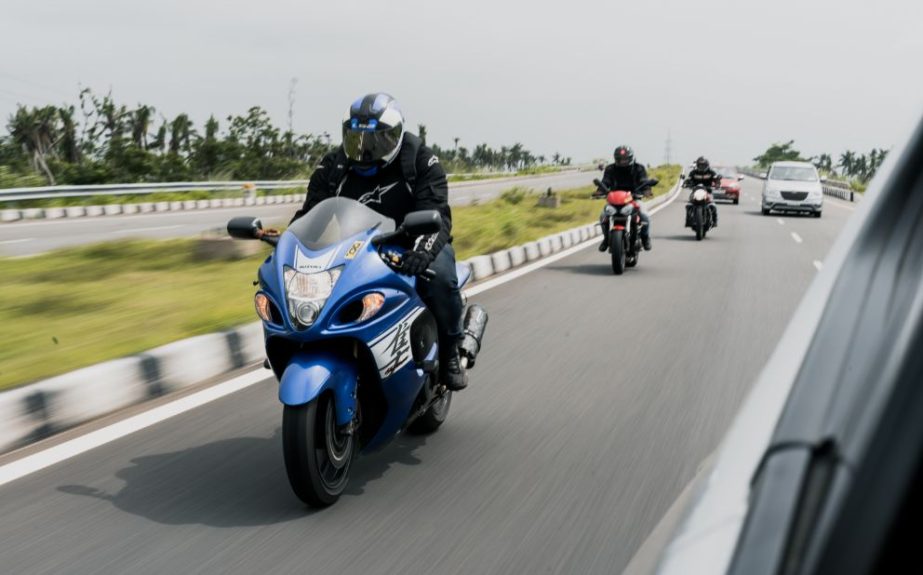|
|
Last Modified on Jan 22, 2024
Being a motorcyclist can be dangerous on some roads, especially with the fear of being rear-ended by another motorist in the back of your mind. Lane splitting was legalized in the state of California in 2017, and despite being practiced by many motorcyclists in California and across the country, it is a very controversial topic due to the potential dangers of causing an accident. In this case, a California motorcycle accident attorney can provide assistance.
What Is Lane Splitting?
Section 21658.1 of the California Vehicle Code defines lane splitting as driving a motorcycle, with two wheels on the ground, in between rows of vehicles that are either stopped or moving in the same lane. This includes vehicles on highways, roadways, or streets that are divided as well as undivided. Typically, a motorcyclist engaging in lane splitting does so when there is little traffic movement or when traffic is at a stop.
Advantages of Lane Splitting
When some people think of lane splitting, they might picture someone on a motorcycle, speeding through the spaces between cars, one wrong move away from a collision. While lane splitting can potentially be dangerous, there can be some advantages as well when a motorcycle rider engages responsibly. These advantages may include:
- Less Traffic Congestion – motorcyclists who practice lane splitting are free to maneuver through slower or stopped traffic smoothly. This can help the flow of traffic and might even reduce some of the congestion.
- Less Risk of a Rear-End Collision – Rear-end collisions are common in high-traffic situations, especially in stop-and-go traffic. Lane splitting allows motorcycle riders to avoid these situations.
- More Visibility on the Road – Motorcyclists are generally more visible to the other vehicle drivers on the road when they are lane splitting versus when they are sitting in traffic. Being more visible to others can keep riders safe, especially when on the highway.
- Less Severe Injuries – A notable study that was done by the University of California Berkeley showed that motorcyclists who did engage in lane switching suffered less severe injuries, such as brain injuries, body injuries, and even fatalities.
While more visibility is an advantage of lane splitting, there are some cases where a motorcycle could also be less visible. This is especially true when motorcyclists are speeding or riding past bigger vehicles that may not see them in their blind spots. This is why it is essential to maintain a reasonable speed and take precautions to make yourself visible to other drivers.
California Lane Splitting Safety
Provided by the California Highway Patrol, here are some helpful tips to make sure motorcyclists stay safe when lane splitting:
- Make sure you are fully aware of your environment when you lane split, including how wide the lanes are, the size of vehicles around you, the weather, the state of the road, and the lighting conditions.
- Be aware of the increased danger that comes with increased speed. Whether you are going much faster than other vehicles or with the flow of traffic, there is potential for a vehicle accident. It is not advised to lane switch when traffic is going faster than 30 mph.
- Try to split between the lanes that are on the far left, as it is typically a much safer way to lane split than between any of the other lanes.
- Try not to lane split next to any larger vehicles, such as buses, big rigs, and RVs.
- Do not ride on the shoulder of the road. This is illegal and not considered lane splitting.
- Make yourself as visible as possible. Try to avoid riding in blind spots or staying in between vehicles if you can help it.
- Help other drivers see you by using your lights, even in the daytime, and wearing bright clothes and gear.
FAQs About Lane Splitting Legality in California
Is Lane Splitting Still Legal in California?
Yes, lane splitting is currently still legal in California and has been since 2017. It is the only state in the country that recognizes lane splitting as a legal practice done by motorcyclists. It doesn’t matter if traffic is moving or at a standstill or if the road is divided or undivided. It is crucial that all motorcyclists continue to obey the laws of the road while lane splitting, including traffic laws and speed limits, to decrease dangers and any possibility of an accident happening.
Does California Have a Dead Red Law?
In California, no vehicle is allowed to run a red light for any reason. All vehicles must stop at the red light and wait for it to change to green before proceeding through an intersection. A motorist who approaches an intersection where the traffic signal is inoperative may continue through with caution after stopping.
Who Is at Fault in a Lane-Splitting Accident in California?
Since lane splitting is legal in California, motorcyclists who participate in it generally have the right of way on the road. If they are hit by a driver of another vehicle, that driver can be held responsible for the accident. All drivers should be alert, careful when changing lanes, and cognizant of motorcyclists when driving.
How Much Safer Is Lane Splitting?
Although lane splitting may seem risky and dangerous when done with caution, it may be a safer option than staying in the lane and following the flow of traffic. This means going no more than 10 mph more than other vehicles on the road, adhering to traffic laws, and avoiding lane splitting around bends or curves. Motorcyclists who take part in safe lane splitting may reduce the risk of being involved in dangerous accidents, such as rear-end collisions.
Consult With Corrales Law Group Today
Despite the many opinions on the dangers of lane splitting, it is still heavily practiced and legal in California, and several other states have no current laws against it. It is possible for lane splitting to be done safely and result in fewer motorcycle accidents, but that doesn’t mean accidents are not bound to happen occasionally. If you are involved in a motorcycle accident involving another vehicle, please do not hesitate to contact a California motorcycle accident attorney at Corrales Law Group.




